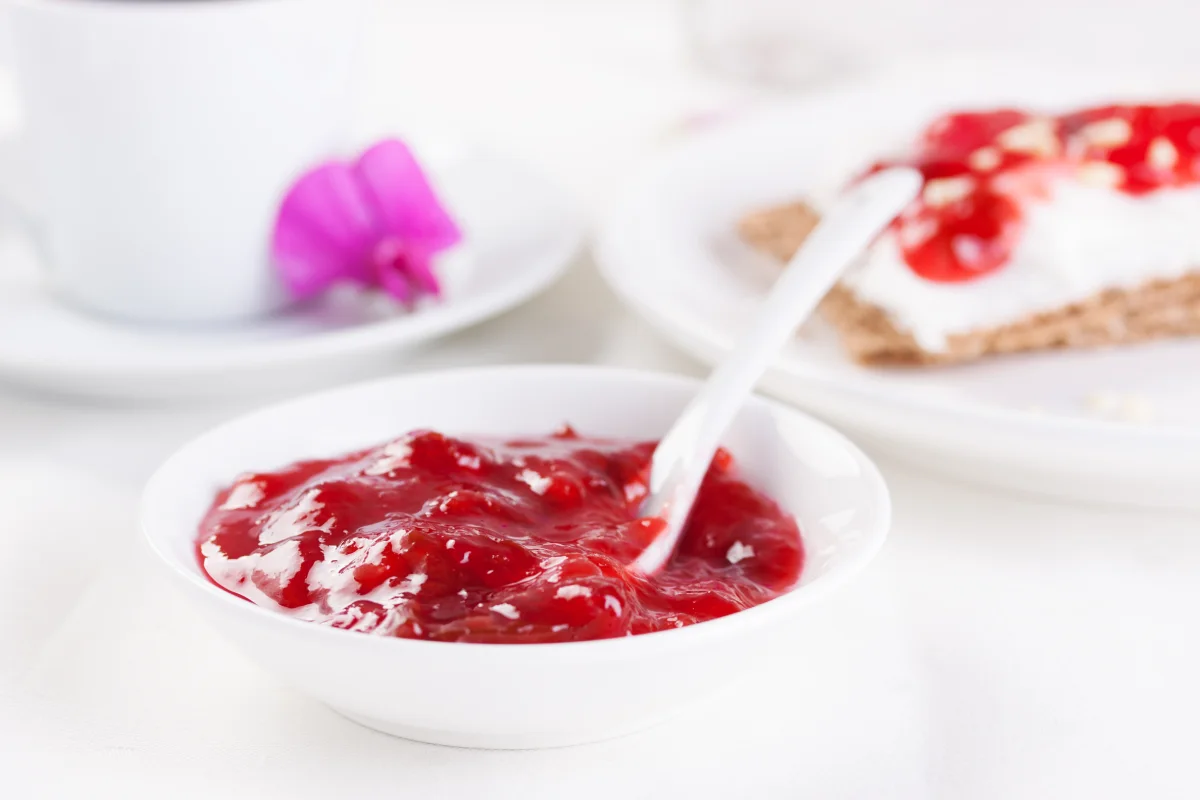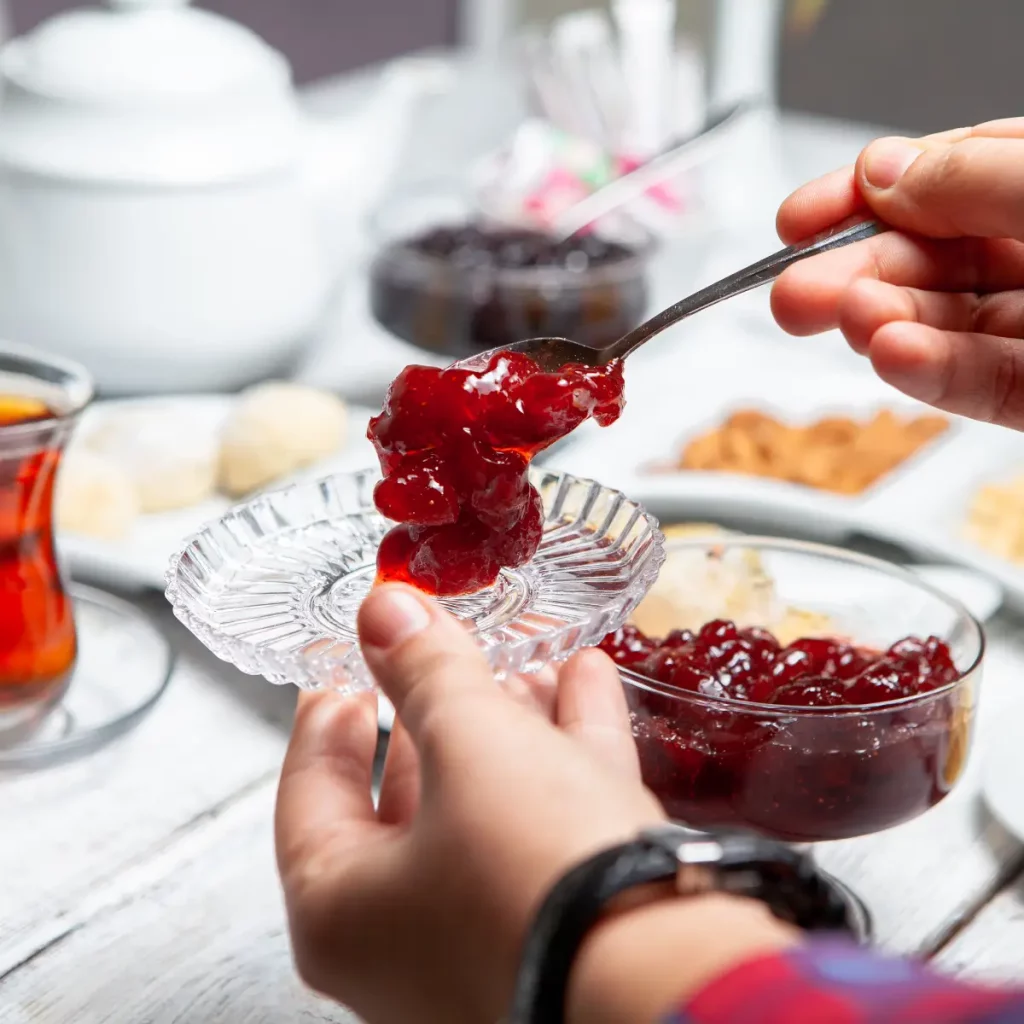Introduction to Cranberry Sauce
Cranberry Sauce Serving, whether hot or cold, is a crucial decision for any festive meal. In this guide, we delve into the best practices for serving this classic holiday condiment, providing you with essential tips, delicious recipes, and answers to common FAQs to elevate your dining experience.
Cranberry sauce, a quintessential element of Thanksgiving feasts, sparks a unique debate: should it be served hot or cold? This tart and sweet condiment has a rich history, deeply rooted in holiday traditions. Whether you prefer the homemade variety or the ease of canned sauce, cranberry sauce remains a staple. Its versatility and vibrant flavor profile have made it a beloved part of holiday meals. As we delve into this culinary conundrum, we’ll explore various aspects of cranberry sauce, from its preparation to the best ways to serve it. Understanding the nuances of this holiday tradition can enhance your festive meals and offer new perspectives on a classic dish.
Types of Cranberry Sauce
When it comes to cranberry sauce, the variety is key. The two main types are homemade and canned, each with its unique characteristics. Homemade cranberry sauce often features whole berries and can be customized with various flavors. On the other hand, canned cranberry sauce, known for its convenience, comes in two forms: whole berry and jellied.
The debate extends to cranberry relish and chutney, offering uncooked alternatives with a more textured consistency. These variations often incorporate additional fruits and spices, providing a more complex flavor profile. For those interested in the different types of cranberry sauce and their preparation, Epicurious offers a comprehensive guide.
Choosing between these types depends on personal preference and the desired texture and flavor in your holiday meal. Each type brings its unique charm to the table, whether it’s the rustic feel of homemade sauce or the nostalgic simplicity of the canned variety. Exploring these options can lead to delightful culinary discoveries and new holiday traditions.
Serving Cranberry Sauce
The question of whether cranberry sauce should be served hot or cold is a matter of personal preference, but there are some general guidelines to consider. Traditionally, cranberry sauce is served at room temperature or slightly chilled, which helps to enhance its flavor and texture. Serving it cold can provide a refreshing contrast to the warm dishes typically found in a Thanksgiving meal.
Pros of Serving Hot:
- Enhances the aroma and can make the sauce more fragrant.
- Some find that warmth complements the tartness of the cranberries.
Pros of Serving Cold:
- The chilled temperature can be a pleasant contrast to other hot dishes.
- Cold serving can enhance the sauce’s texture, making it more gel-like, especially in the case of jellied varieties.
Experts generally recommend serving cranberry sauce at room temperature for the best balance of flavor and texture. For more insights on the ideal serving temperature, Damn Delicious provides useful tips.
Regardless of how you serve it, the key is to ensure that the cranberry sauce complements the other flavors on your plate. Whether you choose to serve it hot or cold, cranberry sauce remains a versatile and essential component of holiday meals.
Preparation Tips
Preparing cranberry sauce can be a simple yet rewarding culinary endeavor. When selecting fresh cranberries, look for firm, plump berries without any soft spots. The color of the berries doesn’t necessarily indicate ripeness, but it can affect the sauce’s thickness and juiciness.
For those making cranberry sauce ahead of time, it can be stored in the refrigerator for up to a week or frozen for longer preservation. This flexibility allows for easy planning and preparation for holiday meals.
A basic homemade cranberry sauce recipe involves simmering cranberries with sugar and water until the berries burst and the sauce thickens. This simple method can be customized with various additions, such as orange zest, cinnamon, or other spices, to create a unique flavor profile. For a straightforward recipe and more creative ideas, Epicurious offers a range of options.
The beauty of cranberry sauce lies in its adaptability. Whether you prefer a classic recipe or enjoy experimenting with different flavors, there’s a version of cranberry sauce for everyone. The key is to balance the tartness of the cranberries with the right amount of sweetness and to achieve the desired consistency, whether you prefer a chunkier relish or a smoother sauce.
Nutritional and Dietary Considerations
Cranberry sauce not only adds a burst of flavor to your holiday meals but also brings nutritional benefits. Cranberries are rich in vitamins and antioxidants, making them a healthy addition to your diet. However, traditional cranberry sauce recipes can be high in sugar.
For those looking for sugar-free or low-sugar options, there are alternatives. Recipes using honey, maple syrup, or sugar substitutes can provide a healthier version while still maintaining the sauce’s desired sweetness and texture. It’s important to note that some sugar substitutes might have a different flavor profile or affect the sauce’s consistency.
Additionally, cranberry sauce can easily be adapted for vegan and gluten-free diets, making it an inclusive dish for all guests. By considering these dietary needs, you can ensure that everyone at your holiday gathering can enjoy this classic condiment.
FAQs
Can I Use Frozen Cranberries? Yes, frozen cranberries can be used in cranberry sauce recipes. They work well in cooked sauces and should be used straight from the freezer without thawing. For uncooked relishes or salsas, fresh cranberries are recommended.
How Do You Thicken Cranberry Sauce? Cranberries are high in pectin, a natural thickening agent. The sauce will thicken as it cools, especially after the cranberries have burst during cooking. If the sauce is too runny, simmering it for a longer period can help reduce the liquid and thicken it.
Does Cranberry Sauce Need to Be Refrigerated? Freshly made cranberry sauce should be refrigerated and can be stored for up to a week. Canned cranberry sauce, once opened, also needs refrigeration. If you’re preparing cranberry sauce on Thanksgiving day, it can be kept at room temperature until serving.
Can I Freeze Cranberry Sauce? Cranberry sauce can be frozen for up to three months. Thaw it in the refrigerator overnight before serving. This is a convenient way to prepare the sauce well in advance.
Alternatives to Cranberry Sauce For those who prefer something different, there are alternatives like ginger-shallot marmalade or citrus-pomegranate relish. These options provide similar tart and sweet flavors but with different textures and ingredients.
For more FAQs and detailed answers, resources like Ocean Spray’s FAQ page and Real Simple’s guide on cranberry sauce offer valuable information.
Creative Uses of Leftover Cranberry Sauce
Leftover cranberry sauce offers a world of culinary possibilities beyond the Thanksgiving table. Its versatility makes it an excellent ingredient for various dishes:
- Sandwich Spreads: Elevate your turkey or ham sandwiches by spreading a layer of cranberry sauce. It adds a sweet and tart flavor that complements the meat beautifully.
- Glazes for Meats: Cranberry sauce can be thinned out and used as a glaze for meatballs, pork chops, or even chicken.
- Dessert and Breakfast Ideas: Stir some cranberry sauce into yogurt for a fruity breakfast option, or use it as a topping for desserts like cheesecake or ice cream.
These creative uses not only add flavor to your dishes but also help in reducing food waste. For more ideas on utilizing leftover cranberry sauce, Pinterest has a plethora of recipes and inspirations.
Conclusion
In conclusion, whether cranberry sauce is served hot or cold largely depends on personal preference and the context of the meal. Its versatility, from the type of sauce to the way it’s served and used in recipes, makes it a fascinating and essential element of holiday cooking. By understanding the different aspects of cranberry sauce, from its preparation to its nutritional value and creative uses, you can enhance your holiday meals and explore new culinary territories. Remember, the key to a great cranberry sauce is balancing the natural tartness of the cranberries with your preferred level of sweetness and achieving the desired texture. This holiday season, embrace the versatility of cranberry sauce and make it a standout component of your festive feast.
For more information on cranberry sauce and its various aspects, resources like Wikipedia’s page on Cranberries and Pinterest’s collection of Cranberry Sauce Variations offer extensive insights and ideas.


